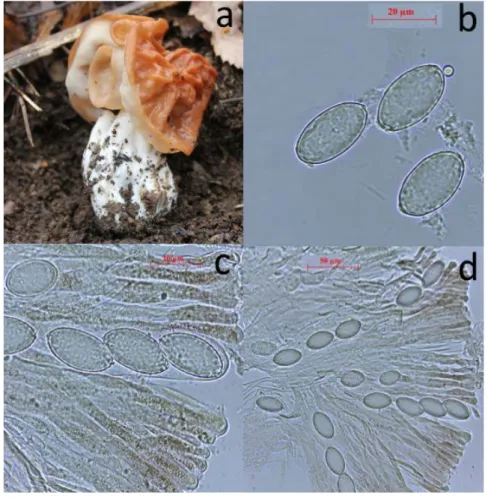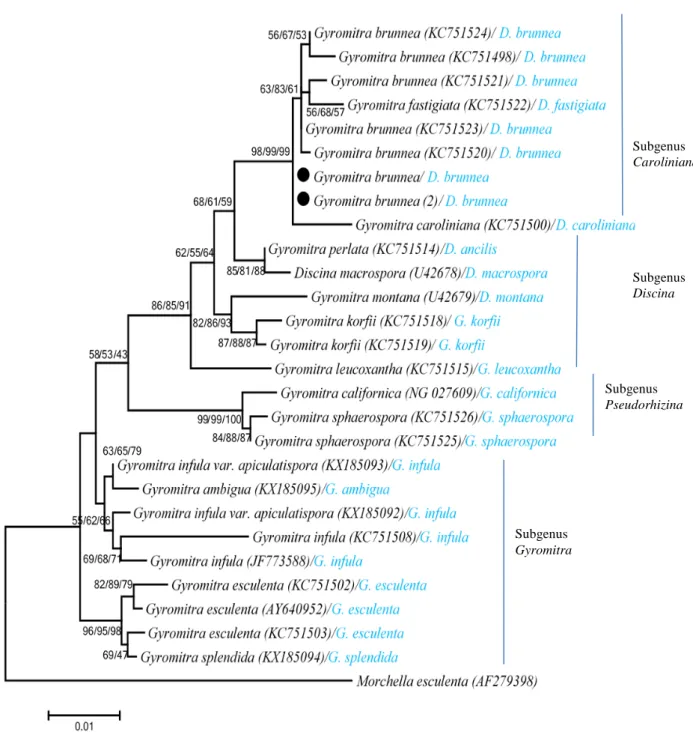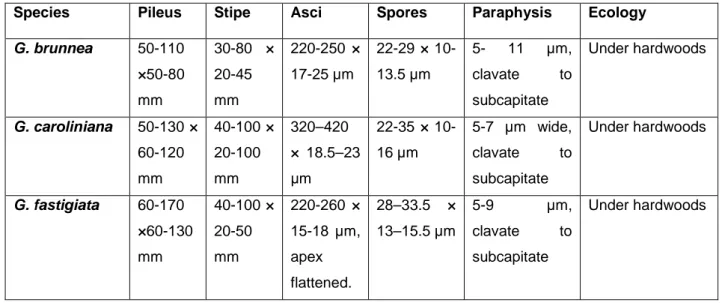Geliş(Recevied) :25/05/2018 Kabul(Accepted) :18/09/2018
Research Article Doi:10.30708/mantar.427101
Morphology and Phylogeny Reveal a New Record
Gyromitra for Turkish Mycobiota
İsmail ACAR
1, Ayşenur KALMER
2,
Yusuf UZUN
3, Ayten DİZKIRICI TEKPINAR*
2*Corresponding author: aytendizkirici@gmail.com
1Department of Organic Agriculture, Başkale Vocational High School, Van Yüzüncü Yıl
University, 65080 Van, Turkey
2Department of Molecular Biology and Genetics, Van Yüzüncü Yıl University, 65080 Van,
Turkey
3Department of Pharmaceutical Sciences, Faculty of Pharmacy, Van Yüzüncü Yıl University,
65080 Van, Turkey
Abstract: In the current study, Gyromitra brunnea Underw. belonging to the family Discinaceae was recorded for the first time from Turkey. Two candidate samples were described by using both morphological and molecular data. Short description of the newly reported species was given together with its photographs related to macro and micromorphologies and discussed briefly. Additionally, phylogenetic position of Gyromitra brunnea was indicated in the phylogenetic tree constructed based on the sequence of 28S (LSU) rRNA gene.
Key words: Gyromitra brunnea, fungal taxonomy, new record, LSU, phylogeny
Türkiye Mikobiyotası İçin Yeni Kayıt Gyromitra’nın Morfolojik ve
Filogenetik Olarak Ortaya Çıkarılması
Öz: Bu çalışmada, Discinaceae ailesine ait olan Gyromitra brunnea Underw. Türkiye için ilk kez kaydedilmiştir. Hem morfolojik hem de moleküler veriler kullanılarak iki örnek tanımlanmıştır. Rapor edilen yeni kayıt türün kısa açıklaması, makro ve mikromorfolojiyle ilgili fotoğraflar ile birlikte verilmiş ve kısaca tartışılmıştır. Ek olarak, Gyromitra brunnea'nın filogenetik konumu, 28S (LSU) rRNA gen dizisine dayalı olarak oluşturulan filogenetik ağaçta gösterilmiştir.
Anahtar kelimeler: Gyromitra brunnea, fungal taksonomi, yeni kayıt, LSU, filogeni Introduction
Gyromitra Fr. (Discinaceae) is a widespread macrofungus genus of Ascomycetes and is represented by 76 species worldwide (www.MycoBank.org; Robert et al., 1999). The genus has brain shaped ascocarps with generally reddish brown to yellowish brown and well developed stems. Most of Gyromitra species are poisonous and causes gastrointestinal syndrome. There is limited number of reliably identified Gyromitra species due to many taxonomic problems between Discina and Gyromitra genera. In regards to mutual generic boundaries among them, reliable and exact taxonomical studies have not been established (Van Vooren and Moreau, 2009). For instance, Fries (1849) considered that Discina and Gyromitra were different genera. However, Harmaja (1969) suggested calling Discina perlata Fr. and
D. leucoxantha Bres. species as Gyromitra perlata and G. leucoxantha, respectively stating that the name Gyromitra is older than the name Discina. He also transferred Discina macrospora Bubak to Gyromitra genus (Harmaja, 1973). Eventually, Discina was accepted as a subgenus of Gyromitra by Abbott and Currah (1997).
Taxonomic ambiguities between these taxa have been originated from traditional classification which is unclear due to similar morphological and ecological features. Therefore, not only morphological characters but also molecular data are needed to identify macrofungus, correctly (Undan et al., 2016). All eukaryotic and prokaryotic cells contain rRNA genes which are widely conserved during evolutionary time and they are used for phylogenetic classification. The LSU (28S) region has been used extensively for fungal phylogeny and taxonomic
MANTAR DERGİSİ/The Journal of Fungus Ekim(2018)9(2)176-181
placement (Asemaninejad et al. 2016). This region contains the D1 and D2 hypervariable domains which are valuable for species identification in various fungal groups (Raja et al. 2017). Methven and his colleagues (2013) resolved nomenclatural problems between Discina and Gyromitra taxa by using sequences of 28S rRNA gene region. They show that Discina macrospora nested with Gyromitra perlata with high bootstrap value and produced Discina subgenus and at the end of the study they proposed five subgenera for the genus as Gyromitra, Discina, Caroliniana, Pseudorhizina and Melaleucoides. In their study, G. brunnea was also studied and characterized by an apical hymenophore that has 2-5 distinct lobes with thick margins, seams joining the lobes and a whitish undersurface that is partially exposed. This sample was also characterized by Kuo (2012) and he distinguished the species from other Gyromitra species by reddish brown cap, which is decidedly lobed and often gathered into two or three points, creating a saddle-shaped appearance.
According to the checklists of Turkish macrofungi, six Gyromitra species are found in Turkey and Gyromitra brunnea has not been previously reported (Sesli and Denchev, 2014; Solak et al., 2015). Therefore, the main goal of the present study is to identify the collected specimens by using both morphological and molecular data and add newly reported species, Gyromitra brunnea, to the macrofungi of Turkey.
Material and Method
Taxon sampling and morphological studies The macrofungus samples were collected from Şemdinli district of Hakkari, Turkey. Two samples, representatives of Gyromitra brunnea, were collected and used for morphological and molecular studies. Collected samples were deposited in the Fungarium of Van Yüzüncü Yıl University (VANF). Specimens were photographed in situ, using with a Canon (EOS 60D) camera equipped with Tokina 100 mm macro lens during field work. Macroscopic characters (cap and stipe) were recorded using fresh materials. Microscopic structures (ascus, paraphysis and ascospores) were observed in distilled water under a Leica EZ4 stereo microscope and sections were examined under a Leica DM500 research microscope. Microscopic structures were measured with the Leica Application Suite (version 3.2.0) programme and described based on different studies [Murrill (1913), Bresinsky and Stangl (1977), Bon (1991), Breitenbach and Kränzlin (1991), Dähncke (2004), Jordan (2004), Gerault (2005), Clémençon (2009), Vizzini et al. (2011), Buczacki (2012), Garcia et al. (2013), Kuo and Methven (2014)].
DNA extraction, PCR amplification and Sequencing
Total DNA was extracted from dried ascomata using the CTAB method (Doyle and Doyle, 1987). The purity and quantity of extracted DNA were determined by using
NanoDrop2000c UV–Vis Spectrophotometer (Thermo Scientific) and 0.8% agarose gel electrophoresis. DNA amplification was performed in a 25 µl volume mixture containing genomic DNA (10 ng/µl), 10X PCR Buffer, MgCl2 (25 mM), dNTP mixture (10 mM), selected primer
pair (10 µM), Taq polymerase (5u/µl) and sterile water. Primer pair for LSU; LROR 5’ACCCGCTGAACTTAAGC3’/LR5
5’TCCTGAGGGAAACTTCG3’ (Vilgalys and Hester, 1990) was used for amplification (Figure 1). PCR products were run in a 1.0 % agarose gel and visualized by staining with Gelred dye and positive reactions were sequenced with forward and reverse PCR primers using ABI 3730XL automated sequencer (Applied Biosystems, Foster City, CA, USA).
Figure 1. Primers [LROR (forward) and LRS (reverse)] used for amplification of D1 and D2 hypervariable domains of 28S large subunit (LSU). Length of amplified area was about 880 bp.
Sequence alignment and phylogenetic analysis
Sequences of Gyromitra brunnea generated from the current study and additional sequences retrieved from GenBank were combined and analyzed together to see phylogenetic relationships among species in the phylogenetic tree. Even though sequences downloaded from GenBank are named as Gyromitra species, some of them are accepted as Discina species or vice versa in the Index Fungorum. For instance, Gyromitra brunnea, G. fastigiata, G. caroliniana, G. perlata and G. montana are given as Discina brunnea, D. fastigiata and etc. in the Index Fungorum. Border of the region was decided using sequence downloaded from GenBank database (Gyromitra brunnea accession no; KC751521, Methven et al., 2013). All sequences were aligned with the aid of the program ClustalW (Thompson et al., 1994).
Prior to construction of phylogenetic tree, total nucleotide length (bp) and variable sites were calculated using Molecular Evolutionary Genetics Analysis software (MEGA 6.0; Tamura et al., 2013). Phylogenetic tree was constructed using two different methods; Maximum Likelihood (ML) and Maximum Parsimony (MP). To test branch support, bootstrap analysis was used with 1000 replicates. Morchella esculenta (KM485969) was utilized as an outgroup (Methven et al., 2013). In the ML method, initial tree(s) for the heuristic search were obtained automatically by applying Neighbor-Joining and BioNJ
algorithms to a matrix of pairwise distances estimated using the Maximum Composite Likelihood (MCL) approach, and then the topology with superior log likelihood value was selected. The Tree-Bisection-Reconnection (TBR) search method was employed with 100 random addition replications to construct the MP trees and the consensus tree inferred from 10 most parsimonious trees was used. All positions containing gaps and missing data were eliminated.
Results
Macroscopic and Microscopic Characters Ascocarp; 50-110 × 50-80 mm, 2-5 lobes in different shapes but usually saddle-shaped, pinkish brown, reddish brown or tan color, loose, wrinkled, often
as if planted with lobed lines, hairless, whitish and often associated with the stipe. Stipe; 30-80 × 20-45 mm, irregularly but usually slightly widening to the base, pale pinkish color or white color, hairless, generally near to base is protruding. Asci; 17-25 × 220-250 µm, hyaline, 8 spored. Ascospores; 22-29 × 10-13.5 µm, ellipsoid, 1-3 drops, firstly smooth then slightly warty. As the spore matures, ornaments grow in the length of 1-2 μm, these ornaments can then extend to 2-5 μm. Paraphysis; 5-11 μm wide, clavate or slightly lobed, with several septate and orangish-reddish brown (Figure 2).
Hakkari, Şemdinli, Bozyamaç village, under Quercus sp., 37° 22'084"N - 44° 26'384"E, 1371 m, 10.04.2015, Acar 850.
Figure 2. Macroscopic and Microscopic characters of Gyromitra brunnea. a. ascocarp, b. ascospores, c-d. asci and paraphysis.
Molecular phylogeny
LSU data matrix consists of 27 sequences and the aligned data was about 881 bp length. The final alignment included 126 polymorphic nucleotides with 65 parsimony informative sites. Sequences of the studied region were submitted to GenBank and the accession numbers were assigned as MH376402 and MH698933 for two different specimens. The Maximum Likelihood analysis resulted in similar phylogenetic topologies with Maximum Parsimony
and Neighbour Joining analyses so only ML tree was given and discussed. Bootstrap values of the all used algorithms were also given in the tree by separating slash sign (Figure 3). The phylogenetic tree composed from four clades and each of them corresponded one subgenus as Caroliniana, Discina, Pseudorhizina, Gyromitra. Determination of subgenus was done according to the study of Methven et al. (2013). The Caroliniana clade consisted of all G. brunnea samples (including studied specimens) with a
MANTAR DERGİSİ/The Journal of Fungus Ekim(2018)9(2)176-181
bootstrap value of 98 % (Figure 3). Gyromitra fastigiata and G. caroliniana samples located closely to G. brunnea in this clade. Although these three species are
morphologically similar they can be distinguished from each other based on some macroscopic and microscopic characters (Table 1).
Figure 3. Phylogenetic tree of Gyromitra species based on ML analysis of the LSU rRNA gene region. Black circles indicate studied specimens. Morchella esculenta was used as outgroup. Bootstrap analyses of ML, MP, NJ were based on 1000 replicates and values higher than 50% were indicated on branches, respectively. The names written before and after the slash are the names accepted by GenBank and Index Fungorum, respectively.
Subgenus Gyromitra Subgenus Pseudorhizina Subgenus Discina Subgenus Caroliniana
MANTAR DERGİSİ/The Journal of Fungus Ekim(2018)9(2)176-181
Table 1. Comparisons of G. brunnea, G. caroliniana and G. fastigiata based on macroscopic and microscopic characters. Species Pileus Stipe Asci Spores Paraphysis Ecology
G. brunnea 50-110 ×50-80 mm 30-80 × 20-45 mm 220-250 × 17-25 µm 22-29 × 10-13.5 µm 5- 11 µm, clavate to subcapitate Under hardwoods G. caroliniana 50-130 × 60-120 mm 40-100 × 20-100 mm 320–420 × 18.5–23 μm 22-35 × 10-16 µm 5-7 µm wide, clavate to subcapitate Under hardwoods G. fastigiata 60-170 ×60-130 mm 40-100 × 20-50 mm 220-260 × 15-18 µm, apex flattened. 28–33.5 × 13–15.5 µm 5-9 µm, clavate to subcapitate Under hardwoods Discussion
Gyromitra genus has many taxonomic problems because of morphological similarities among the specimens. Especially, taxonomic position of the genus with Discina taxon is very problematic. According to Fries (1849) Discina and Gyromitra are two different genera. However, Harmaja (1973) reduced Discina to a subgenus in Gyromitra based on ascospores features. Several recent studies (Abbott and Currah 1997, Van Vooren and Moreau 2009, and Methven et al 2013) and data taken from current study confirmed this arrangement by using additional specimens and phylogenetic analyses. At this point, we used both morphological and molecular data to get correct and reliable results for identification of Gyromitra brunnea.
Methven and his colleagues (2013) showed that Discina samples nested in Gyromitra species and they propose five subgenera for the genus (Gyromitra, Discina, Caroliniana and Pseudorhizina) by using sequences of 28S rRNA gene region. The data taken from present study supported their results; Discina samples retrieved from GenBank (Discina macrospora, U42678) located within Gyromitra species. This sample is called as Gyromitra macrospora in the Index Fungorum. Same situation was also observed in G. brunnea, G. fastigiata, G. caroliniana, G. perlata and G. montana species that are named under Discina in Index Fungorum. This circumstance indicates complexities between boundaries of Gyromitra and Discina taxa.
Studied sample (G. brunnea) grouped closely with G. fastigiata and G. caroliniana samples in Caroliniana clade (Figure 3). Actually, these species not only
molecularly but also morphologically can be separated from each other. For instance, G. brunnea is characterized by an apical hymenophore with thick margins, lobes usually joined in seam-like lines, a whitish undersurface partially exposed in places while G. caroliniana has a brain-like apical hymenophore that is irregularly wrinkled, lacks the seams and fused to the stipe so that the undersurface is not exposed. Gyromitra fastigiata and G. brunnea resemble each other macroscopically but structure of paraphysis can be used to separate them (Table 1). In addition to macroscopic and microscopic features these three species can also be separated based on nucleotide variations of D1-D2 regions of LSU. McKnight et al. (1987) indicated that G. brunnea may be the same species (or variety) known in some recent European books as G. fastigiata. However, in the current study G. brunnea was separated from this sample based on not only macroscopic features but also molecular data so we named our sample as G. brunnea to avoid uncertainty which originated from different comments in Europe.
The present study is valuable because Gyromitra brunnea from Turkey has never been studied by using morphological and molecular characters. At the end of the study, Gyromitra brunnea was firstly reported for mycobiota of Turkey and the total number of the sepecies was increased from six to seven for Gyromitra genus. However, taxonomic positions of Gyromitra and Discina are still problematic and need exact boundaries for correct identification and nomenclature. Therefore, further studies covering detailed morphological analyses and additional
MANTAR DERGİSİ/The Journal of Fungus Ekim(2018)9(2)176-181
DNA markers are necessary for realiable delimitations of mentioned taxa.
Acknowledges
The authors are grateful to the Van Yüzüncü Yıl University Research Fund (BAP Projects No. 2014-FBE-D122) for its financial support.
References
Abbott, S.P., Currah S., The Helvellaceae: systematic revision and occurrence in northern and Northwestern North America. Mycotaxon 62:1–125 (1997).
Asemaninejad, A., Weerasuriya, N., Gloor, G.B., Lindo, Z., Thorn, R.G., New Primers for Discovering Fungal Diversity Using Nuclear Large Ribosomal DNA. PLoS ONE 11(7): e0159043 (2016). doi:10.1371/journal.pone.0159043
Doyle, J.J., Doyle, J.L., A rapid DNA isolation procedure for small quantities of fresh leaf tissue. Phytochemical Bulletin. 19, 11-15 (1987). Fries, E.M., Systema mycologicum. Vol. 2. Geifswald. 620 p (1823).
Hansen, K., Pfister, D.H., Systematics of the Pezizomycetes--the operculate discomycetes. Mycologia, 98 (6): 1029–40 (2006). Harmaja, H., A wider and more natural concept of the genus Gyromitra Fr. Karstenia 9:9–12 (1969).
Index Fungorum, http://www.indexfungorum.org/names/Names.asp, last accession: 17 May 2017.
Kirk, P.M., Cannon, P.F., Minter, D.W., Stalpers, J.A., Dictionary of the Fungi. 10th ed. Wallingford: CABI. p.512. UK (2008).
Kuo, M. 2012. Gyromitra brunnea. Retrieved from the MushroomExpert.Com Web site: http://www.mushroomexpert.com/gyromitra_brunnea.html (accessed: 04.04.18)
Liu, K., Liu, L., Porras-Alfaro, A., Kuske, C.R., Eichorst, S.A., Xie, G., Accurate, Rapid Taxonomic Classification of Fungal Large-Subunit rRNA Genes. Applied and Environmental Microbiology, 78 (5): 1523–1533 (2012).
McKnignt, K.H., McKnignt, V.B., A Field Guide to Mushrooms: North America. Houghton Mifflin Harcourt, United States (1987).
Methven, A.S. Zelski, S.E. Miller, A.N., A molecular phylogenetic assessment of the genus Gyromitra in North America. Mycologia, 105(5), 1306–1314 (2013).
Raja, H.A. Miller, A.N. Pearce, C.J. Oberlies, N.H., Fungal Identification Using Molecular Tools: A Primer for the Natural Products Research Community. J. Nat. Prod. 2017, 80, 756−770 (2017), DOI: 10.1021/acs.jnatprod.6b01085
Robert, V., Vu, D., Cock, Ad., Schoch, C., (editors) (1999) onward (continuously updated). The MycoBank. Website: http://www. mycobank.org [accessed 10 March 2018].
Sesli E., Denchev C.M. Onward (Continuously Updated). Mycotaxon Webpage. Available online at http://www. mycotaxon.com/resources/weblists.html (2014).
Solak M.H., Işıloğlu M, Kalmış E., Allı H., Macrofungi of Turkey. Checklist. İzmir, Turkey: Üniversiteliler Ofset (2015).
Tamura, K., Stecher, G., Peterson, D., Filipski, A., M., Kumar, S., MEGA6: Molecular Evolutionary Genetics Analysis Version 6.0. Mol. Biol. Evol., 30(12): 2725–2729 (2013).
Undan, J.Q., Alfonso, D.O., Dulay, R.M., Leon, A.M., Kalaw, S.P. Undan J.R., Reyes, R.G., Molecular identification and phylogeny of different macrofungi in Mt. Bangkay, Cuyapo, Nueva Ecija, Philippines based on ITS nrDNA region. Advances in Environmental Biology, 10(12) December 2016, Pages: 35-42 (2016).
Van Vooren, N., Moreau, P.A., Essai taxinomique sur le genre Gyromitra Fr. Sensu lato (Pezizales), 1. Introductionet systématique. Ascomycete.org 1(1): 3-6 (2009).
Vilgalys, R., & Hester, M. (1990). Rapid genetic identification and mapping of enzymatically amplified ribosomal DNA from several Cryptococcus species. Journal of Bacteriology 172: 4239-4246.
![Figure 1. Primers [LROR (forward) and LRS (reverse)] used for amplification of D1 and D2 hypervariable domains of 28S large subunit (LSU)](https://thumb-eu.123doks.com/thumbv2/9libnet/4846466.94588/2.892.473.843.441.555/figure-primers-forward-reverse-amplification-hypervariable-domains-subunit.webp)


